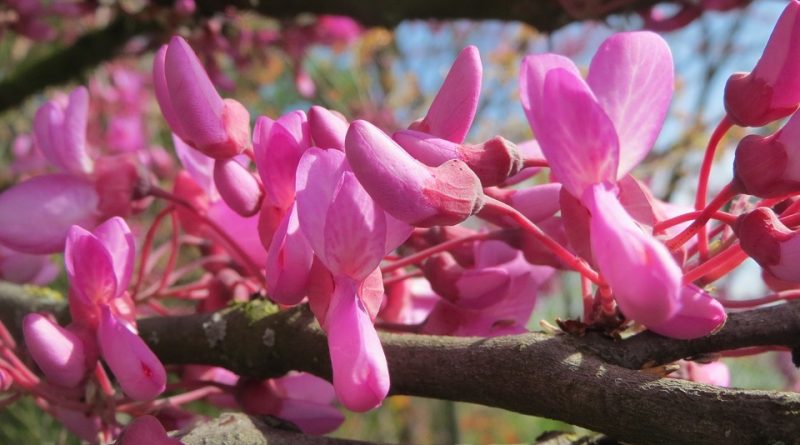Cercis siliquastrum
Cercis siliquastrum
The Judas or Siliquid tree (Cercis siliquastrum, L. 1758) is an arboreal species belonging to the Fabaceae family.
Systematics –
From a systematic point of view it belongs to the Eukaryota Domain, Kingdom Plantae, Magnoliophyta Division, Magnoliopsida Class, Fabales Order, Fabaceae Family, Subfamily Caesalpinioideae, Cercideae Tribe and therefore to the Gender Cercis and to the C. siliquastrum Species.
Etymology –
The term Cercis was taken from Linnaeus by the Greek name κερκίς, cercís in Teofrasto, a sort of white poplar according to some authors, name of the Cercis siliquastrum according to others, but also a loom weaving shuttle whose shape recalls that of its woody pods. The specific epithet siliquastrum has been used as a derogatory of siliqua, epithet of the carob tree: as a false carob tree.
Geographic Distribution and Habitat –
The Cercis siliquastrum is very likely a native plant of the entire Mediterranean and Southern Europe, up to the Black Sea coast. It is found in the bushes with preference in calcareous soils up to 300-400 meters above sea level, in association with holm oak, downy oak, bagolaro, flowering ash and other forest essences. In Italy it is present, usually in bushy formations, and in all the regions up to the Pre-Alps. It is quite resistant to cold.
Description –
The Judas tree is a plant that grows up to 8 meters in height, with rounded, fairly thick, light green foliage. The trunk is slender, more or less oblique and sinuous and has a dark brown bark, cracked and wrinkled. The leaves are deciduous and alternate, with long petiole and rounded heart-shaped or kidney-shaped and light green. It possesses hermaphrodite flowers which are grouped in inflorescences with sessile cluster (4-6), distributed on the whole plant with pink-violet color (the alba variety has white flowers). The antesis is in the period between March and April, before the appearance of the leaves. from fertilization, elongated and flattened legumes are formed which initially have reddish hues and then brown maturity, with a length of 8-12 cm, persistent on the plant throughout the winter period. The seeds are lenticular and dark brown in color.
Cultivation –
The Cercis siliquastrum is a species that is multiplied by seed and it is advisable to transplant the seedling after two years, directly with the ground bread as it presents extreme sensitivity to radical traumas. It prefers a cultivation in full sun, which favors a more abundant flowering. The siliquastro, in addition to needing a good protection from the cold is very sensitive to gusts of wind, while it has good tolerance for air pollution, so it is suitable for its cultivation in urban areas. From the pedological point of view it adapts to different soils, the important thing that they are wet.
Uses and Traditions –
The Judas tree is an arboreal species much appreciated as ornamental; it is frequently used for urban furnishing and parks because of its beautiful spring flowering and its resistance to the city atmosphere. It has a reddish wood veined dark and quite hard, which makes it used in cabinet making.
Like other legumes, it is a nitrogen-fixing plant, so it is able to capture atmospheric nitrogen thanks to the bacteria located in the roots, releasing it into the soil, enriching it.
The flowers are edible (ie edible) and can be used in the kitchen in the preparation of recipes, so much so that in many recipe books, especially northern Europe, especially British, it is often recommended to use the flowers picked fresh to compose great salads.
The popular name of this tree links it to the figure of Judas Iscariot. According to some legends, Jesus was kissed (and betrayed) just under one of these. Others narrate instead as the tree chosen by the disciple to hang himself.
Preparation Mode –
The flowers of this plant can be collected and eaten, either fried in batter or mixed fresh with salads. Some keep them in brine like capers and then use them in soups or pizza dishes and some people keep them in a pickle.
Guido Bissanti
Sources
– Acta Plantarum – Flora of the Italian Regions.
– Wikipedia, the free encyclopedia.
– Treben M., 2000. Health from the Pharmacy of the Lord, Advice and experience with medicinal herbs, Ennsthaler Publisher
– Pignatti S., 1982. Flora of Italy, Edagricole, Bologna.
– Conti F., Abbate G., Alessandrini A., Blasi C. (edited by), 2005. An annotated checklist of the Italian vascular flora, Palombi Editore.
Warning: Pharmaceutical applications and alimurgical uses are indicated for informational purposes only and do not in any way represent a medical prescription; there is therefore no liability for their use for curative, aesthetic or food purposes.


